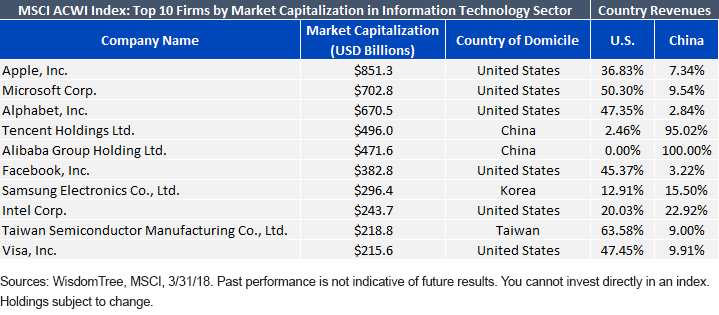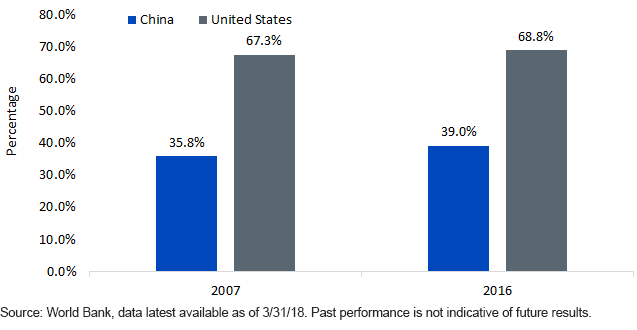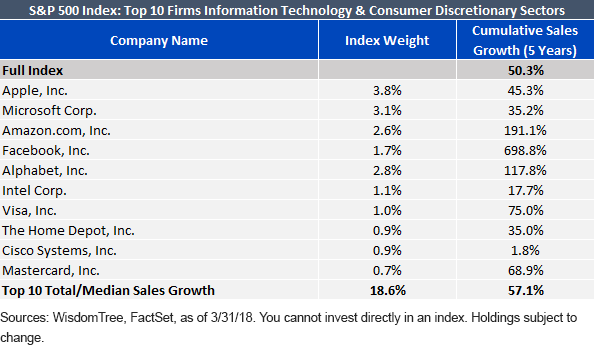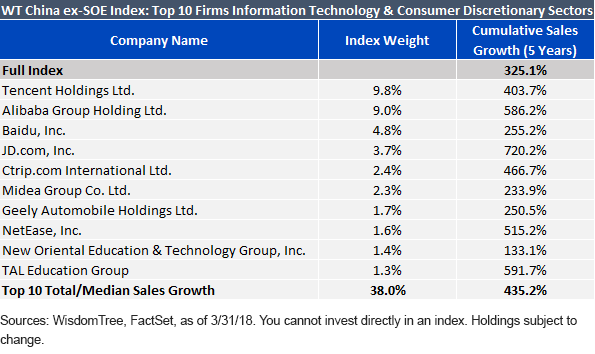China’s Tech- and Consumer-Driven Conversion



Most market participants are likely familiar with the growth of tech and consumer discretionary names in weight and importance in U.S. equities, but some may be overlooking a similarly dramatic change that has materialized in emerging markets. Over the past 10 years, due in large part to the slow and steady liberalizing of capital markets coupled with the exceptional growth of some of the country’s biggest companies, China’s star has risen not only as an economic power, but as an investing destination as well.
The country’s largest companies, primarily in the information technology and consumer discretionary sectors, are joining the ranks of U.S. multinationals atop the charts of the largest, fastest-growing and most recognizable companies in the world. Since the start of 2017, the two largest companies in China have grown their combined market capitalization by more than $500 billion and have ascended to within the top five by size of global information technology companies. Such fast-growing companies are emblematic of the “new China” that is fundamentally different from “old China.” Even more interesting, the rise of China’s national champions has largely been homegrown. As we show in the table below, nearly all of Tencent’s and Alibaba’s revenue was earned in China. This compares to a much more U.S.-centric model for most other large tech firms. This is an important distinction, particularly given heightened regulatory scrutiny in the U.S.
Alibaba and Tencent: Hallmarks of a Sectoral Shift

Shifting Consumer Habits
In our view, the investment case around China 10 years ago, like other export-dependent economies, was critically tied to the value of the yuan and the prospects for global trade. As illustrated with the high percentage of revenue earned in China and the transition toward a more consumption-driven economy, China is less reliant on global growth and trade. The miraculous growth of the first decade of the 21st century was driven by export- and investment-led growth. Chinese policy makers have sought to strike a pragmatist’s balance between maintaining economic growth and overseeing a transition. In every year since 2010, consumption has accounted for greater than half the growth of gross domestic product (GDP), and household consumption as a percentage of total GDP has been steadily increasing toward 40%.1 However, this proportion is still well below developed markets like the United States, where consumption accounts for almost 70% of GDP.
Consumption as Percentage of GDP Well Below U.S.
Household Consumption as % of GDP

Today, the focus for investors is on the changing habits of the population’s increasing and pervasive use of technology and the decades-long trend of a growing middle class that will propel domestic consumption to supplant exports as the engine of growth. Based on 2017 data, of the nearly 753 million Chinese who access the Internet via mobile, more than 65% used their phones to purchase something online. Despite a comparatively low (by American standards) 55.8% Internet penetration rate, China is the most connected country in the world. As such, 40 million people gained access for the first time last year.2 Based on these trends, we believe the rise of Chinese technology and the consumer class will undoubtedly have a profound impact on global markets and investment opportunities going forward.
Largest Companies Driving Innovation and Growth
To establish a baseline of the rapid growth occurring in the technology and consumer discretionary sectors, we highlight the 10 largest technology and consumer companies in the S&P 500. Over the last five years, these businesses have boosted sales by a cumulative 57%. Because they make up nearly 19% of the index, this has led to total returns for each sector of 155.6% and 107.1%, respectively. Among these firms are the most-well-known technological innovators and brands in the world.
Top 10 Weights: S&P 500 Index

Next, we contrast these sales growth figures with the largest tech and consumer companies in China. While many names may appear familiar, many of them may not. This is despite the fact that median sales for these companies have grown in excess of 435% over the last five years. Among the less obvious names is TAL Education Group (TAL). While Alibaba has topped sales growth, TAL has experienced the second highest revenue growth in China over this period. TAL stands poised to benefit from the digitization of the Chinese consumer. It is the largest provider of online tutoring services for children in the world. As China grows richer and the middle class continues to expand, parents will increasingly focus on ways to invest in their children’s education. Companies like this are an example of the powerful combination of technological trends driving household consumption patterns that will power earnings going forward.
Top 10 Weights: WisdomTree China ex-State-Owned Enterprises Index

Conclusion
Two main themes have been guiding our view that investors should seriously consider boosting exposure to Chinese equities over the medium term: capital market integration and domestically oriented earnings potential. We discussed the impact of capital market reforms, including impending A-shares inclusion in MSCI Indexes, in a recent blog post. While active management or stock picking is often utilized when going abroad, we would advocate the merits of reviewing a broad index-based approach given the breadth of the opportunity set. One such index that has been effective in targeting the fast-growing companies we have highlighted, while mitigating the risks associated with unprofitable companies operating at the behest of the Chinese government, is the WisdomTree China ex-State-Owned Enterprises Index. For a deeper look, see our full white paper on this topic.
1Sources: Bloomberg, National Bureau of Statistics, World Bank.
2Source: China Internet Network Information Center, 39th Survey Report, 1/17.
Important Risks Related to this Article
Investing in Chinese issuers involves special risks, including currency devaluations and exchange rate fluctuations; intervention by the Chinese government (including risk of nationalization or expropriation); higher rates of inflation; greater political, economic and social uncertainty; market volatility; and lack of market liquidity. The Chinese financial sector is undergoing significant structural and regulatory changes, which have the potential to adversely affect the profitability of Chinese financial companies. The global deterioration of the credit markets since late 2007 generally has had an adverse impact on a wide range of U.S. and international financial institutions and markets. These domestic and global factors may make Chinese financial companies especially vulnerable to losses from rising interest rates, loan defaults, price competition and credit and equity bubbles and crashes. Consequently, securities issued by Chinese financial companies may exhibit dramatic market price fluctuations.



